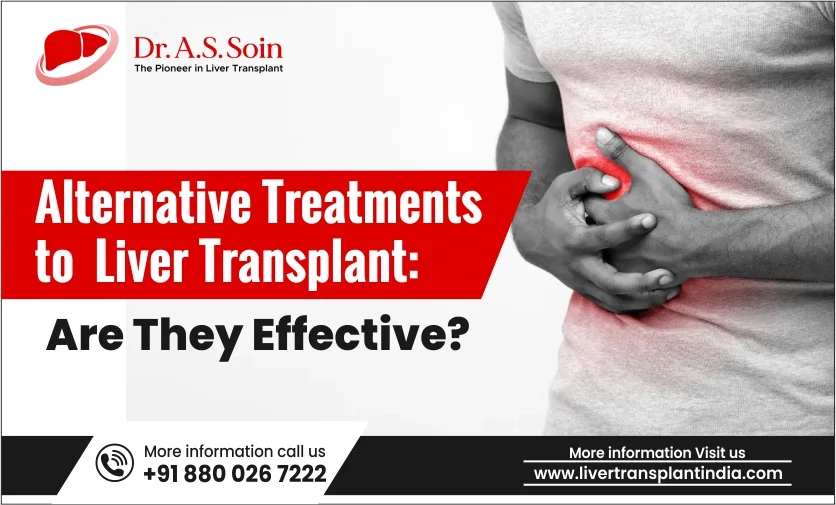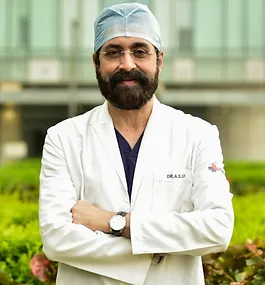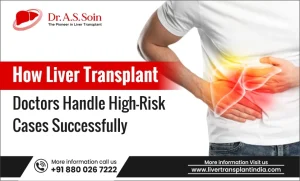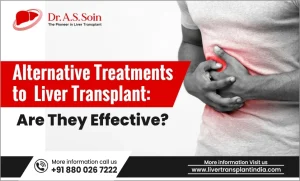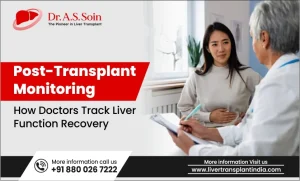Let’s be honest — nobody wants a liver transplant.
The word itself sounds heavy. And when doctors mention it, the first reaction most people have is:
“Isn’t there some other way to fix the liver?”
That’s where all the alternative ideas start coming in — stem cell therapy, herbal medicines, ozone therapy, detox, even things like “liver flushing.” The internet makes them look hopeful, almost magical.
But how much of that is real science, and how much is wishful thinking?
Let’s unpack that properly.
Table of Contents
ToggleWhy People Look for Alternatives
A liver transplant is not an easy decision. It’s expensive, complex, and life-changing. Patients have to take lifelong medications, stay careful with diet and infections, and undergo long follow-ups.
So when someone tells them, “There’s a new therapy that can regenerate your liver without surgery,” it sounds tempting. Especially if they’re already tired, scared, and clinging to hope.
The truth, however, is this: the liver has some power to regenerate — but only up to a limit.
Once the liver cells (hepatocytes) are scarred and replaced by fibrous tissue — as in cirrhosis — that natural healing ability is almost gone. You can’t “detox” or “boost” it back with supplements or home remedies.
Still, let’s go through the main alternative options people talk about — and what medical science actually says about them.
1. Stem Cell Therapy — The Hottest Buzzword
Stem cells are the body’s raw, undifferentiated cells that can, in theory, turn into any kind of tissue — including liver cells. Sounds perfect, right?
Over the last decade, several research teams have tried using stem cells to regenerate the damaged liver. Usually, these are mesenchymal stem cells taken from bone marrow, umbilical cord, or fat tissue, and injected into the bloodstream or directly into the liver.
Here is what studies show:
- Some small studies have found temporary improvement in liver function tests and symptoms — less jaundice, more energy, better appetite.
- But these improvements are often short-lived. After a few months, the liver function starts declining again.
- There’s no clear evidence yet that stem cells can reverse cirrhosis or regenerate a functioning liver structure.
Why it’s not ready yet:
The major problem is cell survival and integration. The fibrotic liver environment doesn’t allow new cells to thrive. Many of them die before even attaching.
Also, there’s no standardized method for which cells to use, how many, or how often.
So at this stage, stem cell therapy is experimental — not an approved replacement for liver transplant.
It may have a supportive role in future, but not today.
2. Ayurvedic and Herbal Remedies — The Old Faith
From bhumi amla to kutki, the market is full of liver tonics claiming to “cure liver failure.” Some combine dozens of herbs, all branded as “natural detoxifiers.”
The reality check:
Some herbs like phyllanthus niruri (bhumi amla) or silymarin (milk thistle) do have mild antioxidant and anti-inflammatory effects. They might help in early fatty liver or mild hepatitis.
But when the liver is scarred or cirrhotic, these herbs can’t rebuild tissue. Worse — some herbal preparations, especially the ones without quality control, can be toxic to the liver itself.
There are multiple documented cases of herbal-induced liver injury.
The irony? People take them to “heal” the liver.
What’s okay:
If a patient is in early stages — like fatty liver, mild fibrosis, or chronic hepatitis — some herbal support can work as an adjunct, under supervision. But for decompensated cirrhosis or liver failure — no herbal mixture can regenerate a dead organ.
3. Ozone Therapy and “Liver Detox” Programs
This one’s popular in wellness clinics and spa-style “medical centers.” Ozone therapy involves infusing ozone gas into the blood, claiming to oxygenate tissues and “cleanse” toxins.
It sounds new-age, but again — there’s no credible clinical data supporting its effectiveness in cirrhosis or liver failure.
Similarly, “liver flush” programs with olive oil, lemon juice, or herbal teas are nothing more than digestive cleanses. The liver doesn’t store toxins like a sponge — it processes them continuously. You can’t flush fibrosis or regenerate cells with juice.
These are marketing tricks, not medicine.
4. Artificial Liver Support Systems (Bioartificial Livers)
Now, this one is interesting and scientific.
Bioartificial liver devices act like temporary support machines that help detoxify the blood — something like dialysis for the liver.
They use filters, plasma exchange, and sometimes even cultured liver cells to remove toxins and bridge the patient until a real transplant is possible.
What they can do:
- Buy time for acute liver failure patients waiting for a donor.
- Stabilize critical patients for a few days or weeks.
What they can’t do:
- Replace the liver permanently.
- Reverse chronic cirrhosis.
So again — this is a support system, not a cure.
5. Gene and Regenerative Medicine — The Future Path
Here’s where science is slowly moving.
Researchers are experimenting with ways to reprogram existing cells inside the body into liver-like cells using gene-editing tools (like CRISPR). Others are working on lab-grown liver tissues that could one day be transplanted like spare parts.
These are early-phase developments. In animal models, they’ve shown promise — but translating that into human therapy is still years away.
If it works someday, it could revolutionize treatment. But right now, liver transplant remains the only proven curative option for end-stage disease.
6. Lifestyle and Nutritional Interventions — The Real but Slow Healers
This may sound simple, but this is actually the most underrated form of liver protection.
If the disease is not advanced, lifestyle correction can truly save the liver.
- Complete alcohol abstinence — even small quantities can accelerate damage.
- Protein-rich, nutrient-dense diet — helps regenerate cells where possible.
- Weight loss and insulin control — crucial for fatty liver and NASH.
- Avoiding unnecessary drugs — many over-the-counter painkillers or herbal combinations can worsen the injury.
These steps don’t “cure” liver failure but can prevent progression to the transplant stage.
So yes — lifestyle is not an alternative to transplant, but it can be an alternative to reaching that stage.
7. Partial or Auxiliary Transplant — The Medical Middle Ground
Sometimes, doctors explore partial solutions before a full transplant.
In an auxiliary liver transplant, part of a healthy donor liver is attached to the patient’s damaged liver. Over time, if the native liver recovers, the donor graft shrinks naturally.
This is not exactly an “alternative” — it’s a surgical innovation within the transplant spectrum — but it’s one of the few genuine options that allow the body a chance to heal while being supported.
Why “Alternative” Treatments Get So Popular
Let’s be real.
Most people don’t trust what they don’t understand.
Liver transplant sounds like a last-resort, high-stakes operation — and doctors explaining it in technical terms doesn’t always help emotionally.
In contrast, someone online or on YouTube saying “I reversed my liver disease naturally” sounds more human, more hopeful.
But in most cases, those stories are partial truths. Maybe the person had fatty liver, not cirrhosis. Maybe their enzymes improved temporarily. Maybe they were never close to needing a transplant in the first place.
Medicine works on reproducible evidence, not anecdotes.
The Emotional Trap of “Miracle” Cures
This is the part nobody likes to admit — fear and denial play a huge role in health decisions.
When someone hears they might need a transplant, their brain starts bargaining:
“Maybe my reports are wrong. Maybe I can fix this naturally. Maybe I just need a detox.”
Alternative healers often use this vulnerability — with comforting language, emotional promises, and “natural” labels. It feels safer than a hospital bed.
But the danger is — precious time gets wasted. Liver failure doesn’t wait for anyone. By the time patients return to doctors, the window for transplant may already be closing.
True hope lies in timely, evidence-based treatment, not in emotional comfort.
So, What’s Actually Effective Before Transplant?
If you catch liver disease early — yes, there are real medical ways to slow or even reverse it:
- Antivirals for hepatitis B and C can prevent further scarring.
- Lifestyle correction for fatty liver (diet, exercise, sugar control).
- Medications like ursodeoxycholic acid for specific biliary conditions.
- Monitoring and intervention for portal hypertension, ascites, varices, etc.
But once the liver reaches end-stage failure, no therapy — not even stem cells or herbs — can replace its function fully.
That’s when liver transplant becomes not an option but the only chance at survival.
Where Alternative Therapies Fit In
Let’s not completely dismiss everything.
Some alternative or adjunct therapies may help support liver health, improve fatigue, appetite, or immunity — when used safely and under supervision.
But using them instead of medical treatment is what turns dangerous.
The goal should be integration, not substitution.
The Honest Bottom Line
It’s okay to explore — but it’s wiser to verify.
Many patients lose precious months chasing unproven treatments when they could’ve been evaluated for a transplant earlier. The liver doesn’t wait; once the cells die, there’s no going back.
That’s the harsh but simple truth.
Takeaway
- Mild to moderate liver conditions can often be managed or improved without transplant.
- Alternative treatments might support liver function, but none can replace it once it’s failed.
- Research is ongoing, and one day stem cells or gene therapy might be real options — but not yet.
If you or your loved one has been advised a liver transplant and are exploring other routes, don’t delay the right consultation.
An experienced liver transplant specialist can assess whether your condition is still reversible — or if waiting longer might make it worse.
Consult with Dr. A. S. Soin — one of India’s leading liver transplant surgeons — to get an expert, honest opinion on your treatment options.
Because in liver disease, the right timing and the right guidance make all the difference.

